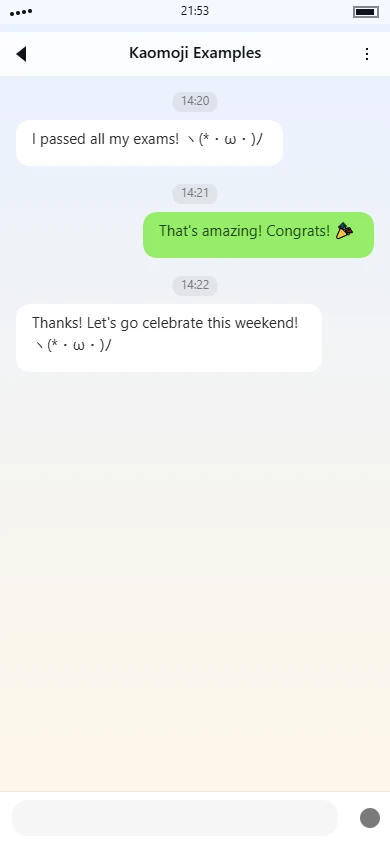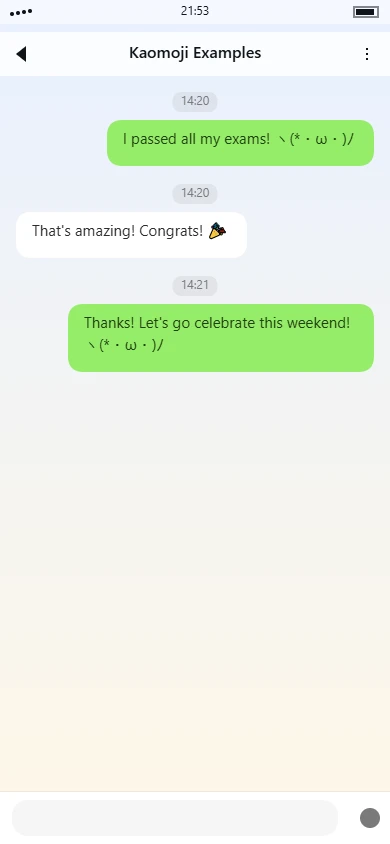\(^▽^)/ kaomoji meaning | usage tips

Overview
This kaomoji presents a stylized representation of a person raising both arms in a celebratory gesture. The overall structure consists of a central facial expression flanked by two upward-slanting arms, creating a symmetrical composition that conveys energetic enthusiasm.
The facial expression at the center uses parentheses to form the face outline, with caret symbols serving as eyes and a triangular mouth made from a combination of characters. The upward direction of the arms, represented by backslashes and forward slashes, suggests a dynamic movement rather than a static pose. This arrangement creates the impression of someone actively celebrating or expressing joy rather than simply smiling.
Symbol Breakdown
- \ and /: These slanted lines represent raised arms, with the backslash on the left and forward slash on the right creating visual symmetry
- ( ): The parentheses form the basic facial outline, containing the expressive elements within a circular shape
- ^^: Two caret symbols placed side by side serve as upward-curving eyes, suggesting a cheerful expression
- ▽: This downward-pointing triangle forms the mouth area, creating a contrast with the upward-facing eyes
- Character spacing: The tight grouping of symbols within the parentheses creates a cohesive facial unit, while the arms extend outward to frame the expression
Emotion & Aesthetic Analysis
This kaomoji conveys a sense of uncontained happiness and celebration. The upward direction of both the arms and the eye symbols creates a consistent visual theme of positivity and elevation. The triangular mouth provides a geometric counterpoint to the curved eyes, adding visual interest to the facial expression.
Compared to simpler happy kaomoji like (^_^), this version includes the additional element of arm movement, which amplifies the emotional intensity. The symmetrical composition contributes to a balanced, harmonious appearance that feels intentionally constructed rather than casually arranged. The use of full-width characters gives the kaomoji a substantial presence in text, making it visually distinct from surrounding content.
The emotional tone is distinctly celebratory rather than merely content. The raised arms suggest an active expression of joy, such as cheering, victory celebration, or enthusiastic agreement. This makes the kaomoji suitable for contexts where strong positive emotion needs to be communicated, such as congratulatory messages, expressions of excitement about good news, or shared moments of triumph. The combination of facial expression and body language creates a more complete emotional representation than facial-only kaomoji.
Tag categories
Use tags to quickly understand this kaomoji.
Usage guide
Usage Guide for \(^▽^)/
This cheerful kaomoji, often called the "happy arms" or "celebration" emote, represents someone raising their arms in pure joy and excitement. The upward-slanting arms (\ and /) frame a beaming face (^▽^) with wide, happy eyes and a broad smile, creating an unmistakable expression of unrestrained happiness. It's one of the most universally positive emotes in Japanese internet culture, conveying everything from simple contentment to overwhelming excitement.
In online communication, \(^▽^)/ serves as a powerful visual expression of celebration, achievement, or pure happiness. The emote carries a tone of genuine, almost childlike enthusiasm that feels both authentic and infectious. It's commonly used when sharing good news, celebrating personal victories, expressing gratitude, or simply spreading positive vibes in conversations. The kaomoji works particularly well in casual settings among friends, gaming communities, and social media platforms where its exaggerated joy feels appropriate and welcoming.
Common Use Cases
- Sharing exciting personal news like getting a new job or passing an exam
- Celebrating small victories like completing a difficult task or reaching a personal goal
- Expressing genuine happiness when friends share their good news
- Reacting to unexpectedly positive outcomes or pleasant surprises
- Showing enthusiastic agreement with someone's excellent idea or suggestion
- Celebrating holidays, birthdays, or special occasions in group chats
- Expressing relief and happiness after a stressful situation resolves positively
- Reacting to funny memes or hilarious content that brings genuine joy
- Showing appreciation for someone's kindness or helpfulness
- Celebrating game achievements or reaching new levels in gaming communities
- Expressing excitement about upcoming events or anticipated experiences
- Spreading positive energy in online communities during challenging times
Example Conversations
-
Friend sharing good news: "I finally got accepted into my dream university!" "That's amazing! \(^▽^)/ So happy for you!"
-
Workplace chat (casual): "The client loved our proposal and signed the contract!" "\(^▽^)/ Team celebration lunch tomorrow!"
-
Gaming community: "Just defeated the final boss after 20 tries!" "\(^▽^)/ Welcome to the champions club!"
-
Social media comment: "After months of training, I completed my first marathon today!" "\(^▽^)/ Incredible achievement! So proud of your dedication!"
-
Family group chat: "The baby just took her first steps!" "\(^▽^)/ Can't wait to see the video!"
-
Planning with friends: "Everyone confirmed they're coming to the reunion!" "\(^▽^)/ This is going to be the best weekend ever!"
Important Notes
- Avoid using this kaomoji in formal business communications, serious discussions, or contexts where professional restraint is expected. Its exaggerated joy might appear unprofessional or inappropriate.
- Be mindful that the extreme enthusiasm conveyed by this emote might sometimes be misinterpreted as sarcasm or mockery, particularly in text-only communication where tone is ambiguous.
- In some Western online communities, this specific kaomoji has become associated with anime and gaming subcultures, so consider your audience's familiarity with Japanese internet culture when using it.
This kaomoji works particularly well on platforms like Discord, Twitter, and gaming forums where expressive emotes are common. Its visual impact makes it excellent for breaking up text and adding emotional weight to positive messages, but remember that moderation is key—overusing any expressive emote can diminish its effectiveness.
Usage examples
Real conversation samples that feature this kaomoji.

Example 1

Example 2
Related kaomoji
You might also enjoy these kaomoji.